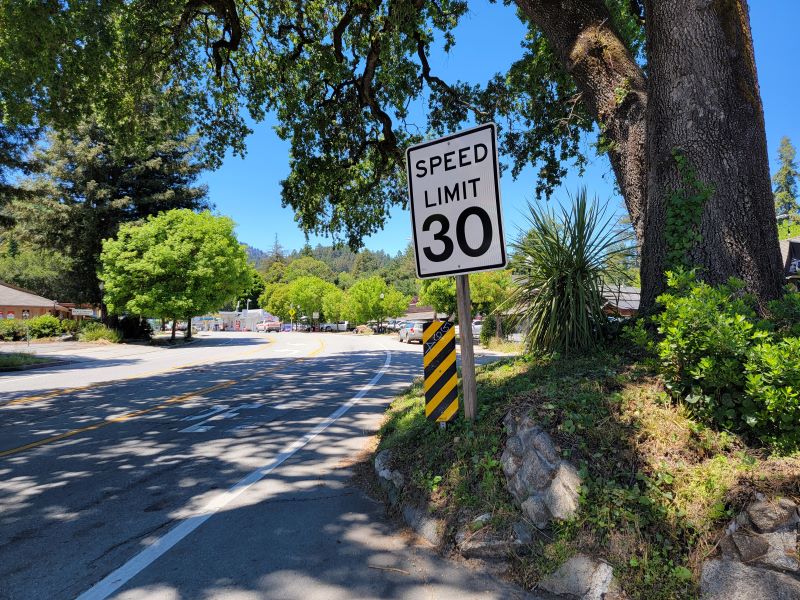Local Officials Request Caltrans to Lower Speed Limits on Highway 9
By James Helmer
The Santa Cruz County Regional Transportation Commission (RTC) is made up of elected and appointed officials from the County of Santa Cruz, all four incorporated cities and Metro Transit District. Its role is long range county-wide transportation planning and distributing state and federal funds for roadway, transit, rail and pedestrian improvements for regionally significant projects. County Supervisor Bruce McPherson who represents the 5th District including San Lorenzo Valley, and the former Mayor of Santa Cruz Mike Rotkin who now represents Santa Cruz Metro, both sit on the RTC. Both are strong advocates for pedestrian and transit user safety. Caltrans (District 5 headquartered in San Luis Obispo) is responsible for all operations, maintenance and capital projects on Highway 9, as well as other state highways in Santa Cruz County, such Highways 1, 35, 236 and 152.
At its May 2 meeting the RTC passed a resolution unanimously requesting Caltrans to lower the speed limits on Highway 9 in downtown Ben Lomond, Brookdale, and the southern portion of Felton to 25 mph. Each of these segments are posted at 30 mph although they are classified in the Vehicle Code as business and residence districts with closely spaced driveways and heavier foot traffic than the segments between all four town centers. The downtown Boulder Creek business district is already posted at 25 mph.
Since the 1950s, if Caltrans decided to post speed limits above the statutory limit of 25 mph in a business or residence district, it based its decision on what is called an Engineering and Traffic Survey (ETS). The ETS consists of having an engineer in an unmarked car measure the speed of a sample of free-flowing traffic using a radar gun, during the day in fair weather, review reported crashes in the prior 12 months, and post the speed limit at or below the nearest 5 mph increment according to the speed that 85 percent of motorists are going (prevailing speed). Engineers conducting the ETS can, but often do not lower the speed limit an additional 5 mph due to roadside conditions such as closely spaced driveways, lack of sidewalks, presence of fixed objects (like trees or guardrails) or lack of lighting (even though high percentages of serious injuries and fatalities occur in the dark and inclement weather). On Highway 9 nearly 40 percent of all reported crashes between 2013 and 2017 were classified as “hit object” rather than a collision between two vehicles. Once the ETS is adopted by Caltrans it is valid for up to 10 years.
As vehicle warning and safety features have vastly improved when compared to older vehicles, the outcome has been a tendency for motorists to feel safer and drive a little faster. Some refer to this as “speed creep.” This is why ETS measurements often result in raising posted speed limits every decade or so. What hasn’t changed is that human bodies are just as fragile as they have always been when struck by a fast-moving hunk of metal. Faster speeds, distracted driving, poor waking conditions, and other physical factors brings us to the sad reality that pedestrian and cyclist deaths account for almost 30 percent of all fatalities on California roadways, while generally making up less than 5 percent of the vehicle counts.
In an effort to proactively reduce crashes on Highway 9 in town centers, the RTC staff cited a new statewide law that took effect in 2021 with the passage of Assembly Bill 43. Among other provisions, this law now authorizes Caltrans to establish a 25 mph speed limit in a business or residence district without an ETS, whereas prior to the law only local agencies like Scotts Valley or the County could do so on local streets. A primary purpose of the law was to give greater emphasis on the safety of all travelers using a highway, especially the most vulnerable pedestrians, cyclists, and those using assisted mobility devices. As Supervisor McPherson became aware of the change in law he wrote a letter to the RTC chairperson supporting staff’s resolution urging Caltrans to lower the speed limits in the three town centers where Highway 9 serves as the “Main Street.” He also highlighted Priority A in the 2019 Highway 9 Complete Streets Plan that identified “reduction of speed limits in the town center areas with commercial uses and heavier foot traffic.”
The adopted resolution by RTC is now being forwarded to Caltrans D5 for its consideration. As Supervisor McPherson points out in his letter: “The current speed limits in the four town centers are inconsistent, causing confusion for motorists who frequently drive too fast to ensure pedestrian and cyclists’ safety and posting all four town centers at 25 mph aligns with the Complete Streets plan.”
While not investigated by the RTC, this author believes that the section of State Highway 236 “Big Basin Highway” extending from the stop sign in downtown Boulder Creek to Redwood Avenue should also be studied for a reduction of the speed limit to 25 mph. It has very heavy foot traffic to the Elementary school, town center, and Post office. Closely spaced driveways and irregular parking patterns have resulted in some property owners taking matters in their own hands by posting homemade signs to slow down. We will provide updates as we learn more about Caltrans response and actions. Contact Supervisor McPherson’s office at fifth.district@santacruzcountyca.gov.
James Helmer is a San Lorenzo Valley native and the former Traffic Engineer for the City of Santa Cruz and Director of Transportation for San Jose.
Featured photo: Speed limit sign by Scarborough Home Center in Ben Lomond (Credit: Julie Horner)
***
Have a news item or community story to share? The team at the San Lorenzo Valley Post welcomes your Santa Cruz Mountains news, story ideas, photos, and letters. Send us an email.
Sign up for our newsletter to stay connected to news and events in the Santa Cruz Mountains.
The San Lorenzo Valley Post is your essential guide to life in the Santa Cruz Mountains. We're dedicated to delivering the latest news, events, and stories that matter to our community. From local government to schools, from environmental issues to the arts, we're committed to providing comprehensive and unbiased coverage. We believe in the power of community journalism and strive to be a platform for diverse voices.





